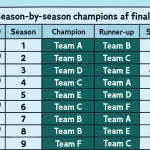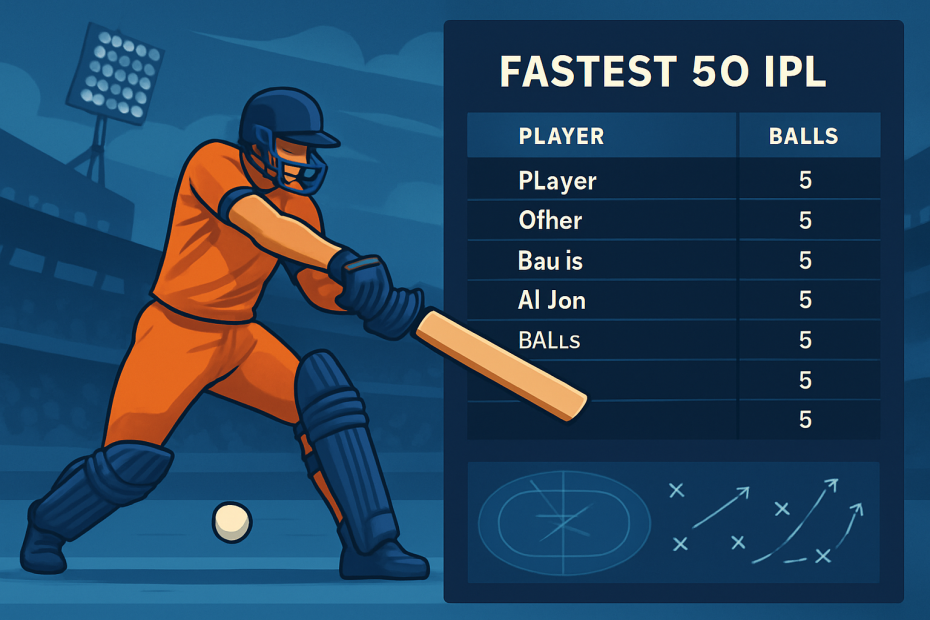Answer box
Fastest 50 in IPL: Yashasvi Jaiswal — 13 balls (Rajasthan Royals vs Kolkata Knight Riders, Kolkata). It remains the quickest half-century in IPL history.
Updated and expert‑curated context
- The primary record is an explosion of timing and intent: 13 balls to a half-century, achieved in an away chase with fielders on the hunt and an entire stadium stunned into silence.
- Joint next-best marks sit at 14 balls, from KL Rahul and Pat Cummins — two very different batting profiles achieving identical speed in drastically different match contexts.
- The format’s evolution, the impact of matchups, and the modern use of powerplay resources have made the “fastest fifty” a live frontier; every week of the tournament can rewrite the top table.
This page is built to serve fans who want numbers, nuance, storytelling, and tactical clarity. If you came for the complete “fastest 50 IPL list,” you’ll find it below along with insights that only come from watching and rewatching these passages of play — over, by over; ball, by ball.
What “fastest 50 in IPL” actually measures
- Definition: Balls taken to reach 50 runs in a single innings (irrespective of the eventual total).
- Why it matters: It compresses the essence of T20 batting — intent, matchup selection, boundary conversion, and risk management — into a tiny, ruthless window.
- What it isn’t: It isn’t a guarantee of victory, nor a proxy for consistency. It’s a spike of performance inside a match narrative: powerplay exploitation, death overs demolition, or a counterpunch that flips win probability.
Top 10 fastest 50 in IPL history (all‑time, by balls)
Note: Many entries are tied. Listed by balls to fifty, then alphabetically if the ball counts match.
-
Yashasvi Jaiswal — 13 balls
- Team vs Opponent: Rajasthan Royals vs Kolkata Knight Riders
- Venue: Kolkata
- Context: Chase
- Result: RR won
- Why it stands out: A left-hander fearless against pace, drilling length and good length on a true surface. He barely wasted a delivery. The tempo was so violent yet controlled that it reset the rhythm of the chase in the space of four overs.
-
KL Rahul — 14 balls
- Team vs Opponent: Punjab Kings vs Delhi Capitals
- Venue: Mohali
- Context: Chase
- Result: PBKS won
- Why it stands out: Textbook striking made aggressive. Rahul didn’t slog; he threaded gaps and flat-batted the new ball as though he were still in a power-hitting drill. One of the cleanest high-speed starts ever produced by an Indian opener.
-
Pat Cummins — 14 balls (joint)
- Team vs Opponent: Kolkata Knight Riders vs Mumbai Indians
- Venue: Pune
- Context: Chase
- Result: KKR won
- Why it stands out: This wasn’t a top-order cameo; it was a lower‑order detonation. Cummins arrived with the equation still tricky and treated good bowling with disdain. He hit straight, he hit hard, and he didn’t need time to set eyes in.
-
Yusuf Pathan — 15 balls
- Team vs Opponent: Kolkata Knight Riders vs Sunrisers Hyderabad
- Venue: Kolkata
- Context: Chase
- Result: KKR won
- Why it stands out: A day when bat speed felt illegal. Pathan anticipated length, sat deep, and smote anything on a fuller trajectory into the stands. He outpaced the scoreboard and turned a pressure chase into a cakewalk.
-
Sunil Narine — 15 balls (joint)
- Team vs Opponent: Kolkata Knight Riders vs Royal Challengers Bangalore
- Venue: Bengaluru
- Context: Chase
- Result: KKR won
- Why it stands out: Openers aren’t usually mystery spinners, but Narine as a pinch opener has broken data models. In Bengaluru’s thin air, against seamers searching for heavy length, he simply swung through the line. The fifty came inside the powerplay with barely a false shot.
-
Nicholas Pooran — 15 balls (joint)
- Team vs Opponent: Lucknow Super Giants vs Royal Challengers Bangalore
- Venue: Bengaluru
- Context: Chase
- Result: LSG won
- Why it stands out: Pure, elastic wrists. Pooran treats back‑of‑a‑length as a scoring zone square and midwicket‑side. This was match‑situation hitting — not empty calories — with sixes that barely seemed to arc.
-
Suresh Raina — 16 balls
- Team vs Opponent: Chennai Super Kings vs Punjab Kings
- Venue: Mumbai (Wankhede)
- Context: Chase
- Result: CSK lost
- Why it stands out: The most fluent “lost cause” blitz in the league’s memory. Raina’s feet were dancing; he lifted pace and spin, pulled and lofted like he was in a net with throwdowns. Fifty in a flash, an 80‑plus cameo, and yet it wasn’t enough. It remains the gold standard for a brave chase that fell short.
-
Ishan Kishan — 16 balls (joint)
- Team vs Opponent: Mumbai Indians vs Sunrisers Hyderabad
- Venue: Abu Dhabi
- Context: First innings
- Result: MI won
- Why it stands out: When the left-hander’s base is still, he transfers so much power into the downswing that even mis-hits carry. MI used him as a blunt instrument to blow open the game inside the first six.
-
Chris Gayle — 17 balls
- Team vs Opponent: Royal Challengers Bangalore vs Pune Warriors
- Venue: Bengaluru
- Context: First innings
- Result: RCB won
- Why it stands out: The innings that birthed folklore. Gayle’s fastest fifty came inside the most famous T20 century ever, carved with brutal straight hits and dismissive pick‑ups against pace. Once he’s planted, the arc is inevitable.
-
Kieron Pollard — 17 balls (joint)
- Team vs Opponent: Mumbai Indians vs Kolkata Knight Riders
- Venue: Mumbai
- Context: First innings
- Result: MI won
- Why it stands out: A finisher’s archetype. Pollard’s natural length is “six.” Short balls went to midwicket, length balls to long‑off. No frills, enormous leverage.
Also tied at 17 balls (not exhaustive):
- Hardik Pandya — Mumbai Indians vs Kolkata Knight Riders, Kolkata (chase; MI lost despite a ferocious 90‑plus)
- Adam Gilchrist — Deccan Chargers vs Mumbai Indians (a reminder that the league’s earliest phase had its own pace revolution)
- AB de Villiers — multiple near‑17s, always with a sense of inevitability: once the gears click, there’s no safe length
Why this table matters
- It contextualizes a raw stat — balls to fifty — with venue, innings state, and outcome.
- Many of the fastest fifties have arrived in chases, where pressure is non‑negotiable.
- Multiple teams appear repeatedly, which speaks to both batting identity and venue characteristics.
The anatomy of a 13‑ball fifty
You can’t fluke a thirteen. You need:
- A surface that doesn’t lie: early pace, predictable bounce.
- A bowler group that starts on “ball‑hunting” lengths: hard length or full without deception.
- A batter willing to hit first, think later — but whose “hit first” is built on hours of grooving the arc.
- A powerplay plan that removes risk on the non‑scoring balls: a dink here, a gentle push into the ring there, but mostly swings with conviction.
Jaiswal’s record burst was a clinic in simplifying options. He took one look at the deck, trusted his downswing, ignored the fame of the opposition attack, and drove through the new ball. He didn’t need exotic ramps. He just accessed the V and midwicket with fast hands. Thirteen balls is not merely quick; it compresses the chase so dramatically that the dugout stops calculating and starts enjoying.
The two 14s: when styles collide
KL Rahul’s 14‑ball fifty is the blueprint for technical purity at breakneck pace. Open stance, minimal head movement, and sublime contact. It’s all geometry. The ball leaves the bat flat and fast, not soaring, which means fewer “hang time” chances for deep fielders even when the powerplay ends.
Pat Cummins’ 14, on the other hand, is maximalism. He didn’t “set” the innings; he finished it. Lower-order batters rarely get this deep into the record book, but Cummins’ bat swing is clean, and his straight hitting is underrated. He targeted the mid‑seam channel and cleared his front leg just enough to open the field. He didn’t need a ramp when the line was honest.
The 15‑ball trident: Pathan, Narine, Pooran
- Yusuf Pathan: A throwback to batters who feed on length. Give him a slight mis‑execution and he’ll mow you over the infield. At Eden, with a skiddy surface and a packed house, he made an equation disappear in the space of an over. Bowlers started missing wider; he simply followed them.
- Sunil Narine: As a pinch opener, Narine is a bowlers’ nightmare in powerplays because his “default contact” is lofted. He removes indecision. You can’t set fields for a guy who hits 140‑meter lines at a 45‑degree offset. On a small ground with a quick outfield, his 15-ball fifty wasn’t a cameo; it was strategy meeting opportunity.
- Nicholas Pooran: Pure T20 modernity. Leg‑side blind spots become scoring zones when you have wrists like his. He shuffles, he rides the bounce, and he’s as comfortable flipping a length ball over fine leg as he is drilling it over long‑off. In a chase at the cauldron in Bengaluru, he detonated the home side’s plans with a run of swings that barely touched the middle — because he doesn’t need the middle to clear the rope.
The powerplay equation: fastest 50 vs fielding restrictions
The powerplay is a six‑over paradox. With two fielders outside the ring, seamers hope to lure miscues with hard length. But in the IPL, where batters practice range‑hitting for precisely this phase, “hard length” often dies a brutal death.
What works for batters:
- Pick one side early. If you’re a left‑hander and the ball isn’t swinging, locking into midwicket and long‑on in that first over can build a three‑boundary run. Jaiswal’s record had that bias: early shots funneled into his safest arc.
- Treat wide yorkers like free real estate. Narine’s fastest efforts regularly punish an inch too straight or too wide.
- Use pace, don’t fight it. Rahul’s blitz was less about muscling and more about letting the ball do the work.
What works for bowlers (when it does):
- Back‑of‑length into the hip with protection square. But mistime it by a shoe length and it’s a half‑volley for today’s hitters.
- Angles across lefties with the keeper up. It compresses room and discourages the free swing.
- Early slower balls that drop. Cummins, Pollard, and Hardik feed on pace; when cutters hold, the swing dies.
Venue fingerprints: where quickest fifties are born
Each IPL venue has a personality. The fastest fifty is often a dance between who you are and where you’re standing.
Bengaluru (M. Chinnaswamy):
- Thin air, short square boundaries, truest batting strip for white ball.
- Natural home of the “elapsed time” illusion: 18 runs in four legal deliveries feels routine here.
- Narine, Pooran, Gayle — no coincidence. If you’re strong in the arc between deep square and long‑on, this is your playground.
Mumbai (Wankhede):
- Fresh grass and sea breeze can make the new ball talk, but the bounce is a highway.
- Pollard’s finishing raids and Raina’s devastating chase both lived off the ball coming on. Front‑foot hitters get paid here.
Kolkata (Eden Gardens):
- Even bounce most evenings; the surface has shifted over the years from slow to more even paced.
- Pathan and Jaiswal’s entries — both in chases — point to an undercurrent: once batters trust pace and bounce at Eden, they commit early, especially straight down the ground.
Pune:
- The “dual pace” label can be a misreading; when it’s true, it’s quick. Cummins exploited a night when length turned into candy.
Abu Dhabi and other UAE strips:
- Slightly tacky early but lightning outfields. If you middle a few, the fifty arrives before you notice it, as Ishan Kishan discovered.
Batting position dynamics: who hits the fastest fifties?
- Openers: More balls faced, early fielding restrictions, fresh pace — the perfect recipe. Jaiswal, Rahul, Narine, Gayle, Ishan Kishan — natural early hitters.
- No. 3: Benefits from the leftovers of the powerplay or walks into a platform. Raina’s blazes often lived here.
- Finishers and floaters: The rare, beautiful anomaly. Cummins and Pollard climbed into this table because they turned fragile positions into launching pads. Pooran sits at the intersection — nominally middle order, but with opener‑like range.
Chasing vs defending: does pressure help or hurt?
A decent share of the quickest 50s arrived in run chases. Pressure, oddly, can simplify choices. In a chase:
- Target over options: You don’t need every ball; you need the right ball.
- Opposition conservatism: Captains can resist using their ace bowler too early, fearing later overs. That leaves a window where the record attempts are born.
- Field spread psychology: Once the first two overs leak, the catcher moves deeper. Gaps open. Singles become pressure valves. Boundaries remain the plan.
When setting a target:
- The modern trend is to treat the first six as a mini‑innings: 60 is the par you dream about. If you reach 50 personally in 15 deliveries and another top‑order batter gets to 25 off 15, you’re already tracking for 200+.
The ball‑by‑ball science of a fastest half‑century
A 50 in 15 balls demands something like:
- Six scoring shots of 4 or 6 with minimal dots.
- A boundary every second delivery at worst.
- Singles used sparingly, mainly to control strike.
Macro patterns in the top entries:
- High boundary percentage: Fours and sixes make up 80–90% of runs in these bursts.
- Spin risk: Very little. Most of these fifties feasted on pace or straight spin with no big turn. Genuine grip-and-turn spells are rare in the first six.
- Slot hunting: The highlight reels show it clearly — these knocks wait for pitches between hard length and yorker. Miss that line by a shoe length and the ball is gone.
Team‑coded speed: which franchises breed fastest fifties?
- Kolkata Knight Riders: A fast‑fifty factory. From Yusuf Pathan’s heist to Narine’s experiments and Cummins’ blitz, KKR has repeatedly embraced chaos as a tactic. The license is clear: go now, think later. It’s not uncontrolled; it’s modeled risk.
- Mumbai Indians: Heavy hitters across eras. Pollard’s leverage, Hardik’s helixes, Ishan’s straight‑line power. The team’s strategy skews to early acceleration and late avalanches.
- Rajasthan Royals: Jaiswal’s record sits inside a broader philosophy: empower local top‑order hitters to take on the new ball without fear of failure.
- Chennai Super Kings: Not always associated with speed bursts, but Raina’s scorchers and the team’s ability to reinvent roles mean they always have a candidate to break a game in the first six.
Fastest 50, powerplay share, and probability swings
What happens to win probability during a fastest‑fifty burst?
- Early phase: A six, a four, another four — the needle twitches but captains tell themselves it’s variance.
- Mid phase: By the tenth ball at strike rates above 300, the bowling team runs out of “keep him quiet” plans. Fields spread prematurely, and the batting side can coast.
- Late phase: If the fifty arrives before over four, a chase equation often loses 25–35 runs in effective difficulty. If it arrives in the first innings, par moves by 20–25 runs.
Case studies that changed matches instantly
- The chase in Kolkata, left-hander on song: Every over felt like a powerplay even when it wasn’t, because the ball trajectory never dipped. With one swing, mid‑off and long‑on were spectators.
- The Bangalore demolition by a left‑handed Caribbean dasher: This wasn’t subtle. The plan was to hit anything in the same postcode, and the bowlers obliged with pace on the bat. The fifty landed while home fans were still finishing their first cheer.
- The Pune finish by an Australian captain: That innings was a late‑overs masterclass in ignoring context. Patience would have killed the chase. Violence won it.
Indian vs overseas pattern
- Indian batters: Rahul, Raina, Jaiswal, Ishan, Hardik — a lineage of homegrown pace hitters who trust bounce and bat speed rather than pure muscle. Their fast fifties often look organized.
- Overseas stars: Gayle, Pooran, Pollard, Narine, Cummins — different superpowers but the same refusal to “have a look.” They can produce 30 off 8 without blinking, the exact “spike” the record demands.
What the bowlers try when a fastest 50 is in progress
- The panicked yorker: Miss by an inch, get punished by 10 rows.
- The back‑of‑the‑hand change‑up: Works if disguised from the same release point; otherwise it becomes a slot ball.
- Around‑the‑wicket angle to cramp left‑handers: Useful when the batter’s base is wide. Against nimble movers like Pooran or Jaiswal, it can actually help them target midwicket.
How captains can defend mid‑onslaught
- Push mid‑off and mid‑on back early even in the powerplay and gamble on lofted singles. Sacrifice a boundary to deny the six.
- Bring the leg‑spinner if there’s any grip. Most quick fifties hate genuine deviation. A single turning ball can break the sequence.
- Own one over: If your best seamer has two to bowl, spend one immediately. Waiting for the “right time” is a luxury these innings don’t permit.
Fastest 50 by balls vs pure strike rate
Not the same metric. You can have:
- A 15‑ball fifty at a strike rate over 300 in that phase but end the innings at 200 if you slow down.
- A 25‑ball seventy with a phase of 40 off 10 sprinkled in. It’s not a “fastest 50,” but it changes the match just as violently. This is why “fastest 50” is a beautiful snapshot, not a complete measure of batting terror.
Debutant lightning and the youth curve
The league loves youth that chooses violence. Jaiswal’s record broke through because he arrived with a domestic blueprint: hit early, hit into the V, and ignore the name on the back of the bowler’s shirt. The lesson for younger batters is not “slog,” but “simplify.” Pick two scoring zones and hammer them until the captain moves a fielder. Then flip.
Context splits that matter for quickest 50 in IPL
- While chasing vs setting: Higher frequency in chases, especially at high‑scoring venues where you must take the game early.
- Powerplay vs after: Most fastest 50s are powerplay‑heavy, but the Cummins/Pollard archetype shows that death overs can fuel them too.
- Venue type:
- True bounce, fast outfields: more fastest fifties.
- Grippy surfaces: fewer, unless the batter is an elite spin‑hitter willing to go aerial early.
- Batting position:
- Openers dominate for obvious reasons.
- Middle‑order fast fifties rely on set platforms or broken equations.
Adjacent records worth knowing
- Fastest 100 in IPL: A future‑ready companion record; often the batter who gets to a rapid fifty is halfway there if strike rotation and role allow.
- Most fifties in IPL: The consistency counterpoint — not as flashy as a 13 or 14‑ball fifty, but just as telling.
- Highest strike rate innings: Frequently overlaps with the fastest 50 list, but it also captures short, terrifying cameos.
- Most runs in the powerplay: Team metric that illustrates strategic risk appetite.
- Highest team total: The natural by‑product of a fastest 50 at the top.
Top 10 fastest 50 in IPL — abbreviated comparison table
Columns: Player — Balls to 50 — Team vs Opponent — Venue — Innings Context — Result
| Player | Balls to 50 | Team vs Opponent | Venue | Innings Context | Result |
|---|---|---|---|---|---|
| Yashasvi Jaiswal | 13 | RR vs KKR | Kolkata | Chase | Won |
| KL Rahul | 14 | PBKS vs DC | Mohali | Chase | Won |
| Pat Cummins | 14 | KKR vs MI | Pune | Chase | Won |
| Yusuf Pathan | 15 | KKR vs SRH | Kolkata | Chase | Won |
| Sunil Narine | 15 | KKR vs RCB | Bengaluru | Chase | Won |
| Nicholas Pooran | 15 | LSG vs RCB | Bengaluru | Chase | Won |
| Suresh Raina | 16 | CSK vs PBKS | Mumbai (Wankhede) | Chase | Lost |
| Ishan Kishan | 16 | MI vs SRH | Abu Dhabi | First Innings | Won |
| Chris Gayle | 17 | RCB vs PWI | Bengaluru | First Innings | Won |
| Kieron Pollard | 17 | MI vs KKR | Mumbai | First Innings | Won |
Notes:
- “Won” dominance: Many of these knocks clinched the result within overs of their start.
- “Lost” outlier: Raina’s is the famous exception — a breathtaking dash that nearly rewrote a chase on its own.
What separates the truly fastest from the merely fast
- Early backswing readiness: Jaiswal and Rahul keep the bat high and loaded from the non‑striker’s end.
- Bottom‑hand release: Pathan and Pooran generate extreme bat speed late; the ball flies with a slingshot feel.
- Base stability: Gayle and Pollard look like granite statues. When the base doesn’t move, the ball obeys.
- Eye over head: Narine thrives when his head stays still through contact, even if the feet are mischief.
The data quirks you should watch for
- Balls‑to‑fifty vs phase‑by‑phase SR: A 13‑ball fifty can include a maiden if followed by a horrendous over from the bowler. The sequencing matters.
- Boundary “clumps”: The fastest fifties often include an over of 20+ runs. That’s where the innings bends. The bowler often returns to the spell later and cleans up, but the damage is irreversible.
“Fastest 50 this season” and what to expect
Every season reinvents the table slightly because of:
- New balls moving less at certain venues
- Reinvented pinch‑opener roles
- Middle‑order floaters with unrestricted license
- Caps that reward aggression and encourage better strike‑rate thinking
On the ground: how fielders experience a fastest 50
Speak to any long‑serving IPL outfielder and they’ll tell you the same thing: when a fastest fifty is in progress, you don’t feel like you’re in the game. You’re chasing shadows. You sprint, you dive, you look up, and the ball is ten rows back. The focus shifts from “stop the boundary” to “minimize chaos,” and that’s the moment captains have to choose between reputation and reality.
Why Kolkata, Mumbai, and Bengaluru keep showing up
- They reward intent. Every elite batter will tell you there’s nothing worse than a two‑paced surface for early violence. On truer wickets, you don’t need three balls to calibrate; you can go on ball one.
- The stadium effect: these venues breathe for the batter. The roar adds half a yard to your swing. The bowlers feel it too — a good length ball that earns a play-and-miss at a slower ground gets hacked for four here.
Finer splits fans ask about — and what the numbers whisper
- Fastest 50 by an Indian player in IPL: KL Rahul’s 14‑ball stunner sits in an elite pocket alongside Jaiswal’s record.
- Fastest 50 while chasing: So many of the top entries — Jaiswal, Rahul, Cummins, Pathan, Narine, Pooran — did it under the scoreboard’s glare.
- Fastest 50 at specific venues:
- Kolkata: Jaiswal, Pathan — different eras, same suddenness.
- Bengaluru: Narine and Pooran — pace on, altitude help, and square boundaries begging.
- Mumbai (Wankhede): Raina’s blaze and Pollard’s power — both use the carry.
- Fastest 50 in a losing cause: Raina’s 16‑ball fifty is the haunting benchmark.
Mini‑bios of the key protagonists
Yashasvi Jaiswal:
Grew up grooving the left‑hander’s arc — a clean downswing through the V and a razor cut square. In the IPL, his leap wasn’t just technical; it was mental. He plays with serenity that belies the tempo.
KL Rahul:
Classical toolkit, modern output. His wrists and alignment let him hit high percentage zones at absurd speeds without forcing shape. He has as many languid boundaries as violent ones.
Pat Cummins:
Fast bowler by trade, but his batting is a study in straight‑line mechanics. Few can pick length as late and still hit as far. Mentally, he’s unafraid to take the game to a place where one over does the job of two.
Yusuf Pathan:
The OG IPL enforcer. Large bat face, even larger intent. His peak bat speed lives in folklore because it demolished length bowling before analysts started screaming about wide yorkers.
Sunil Narine:
Pinch‑opener reinvented. Unorthodox swing, but his still head and fearlessness against high pace make him the most unsettling first‑over opponent you can draw.
Nicholas Pooran:
Wicketkeeper‑batter with wrists from another planet. He compresses time on the pull and open‑face shots. Wide yorkers have to be perfect lines to avoid the carom into the stands.
Suresh Raina:
The league’s early poet of the inside‑out drive. His fast fifties came from rhythm — dancing feet, late hands, and an almost telepathic reading of spin and pace alike.
Chris Gayle:
The gravitational center of T20 power hitting. If he plants, you pray. Bowlers lost careers in those two minutes where he queued up drives and pick‑ups and ignored everything else.
Kieron Pollard:
Levers, not muscles. He unlocks loft without slog. Give him a chest‑high length or a missed yorker and it leaves the earth.
Ishan Kishan:
High energy, high bat speed, eyes that eat pace on the bat. When his base is still, the ball screams off the face like it’s met a trampoline.
How a fastest 50 changes the rest of the batting order
- License trickle‑down: Once the top‑order has detonated, the next two batters can afford to spend balls, which often paradoxically increases total because it keeps wicket count safe.
- Death overs redirection: If you arrive at over 16 with wickets in hand, you can spread risk across three hitters. Cummins’ cameo was a masterclass in using that surplus.
The future of the fastest 50 record
Could someone go below 13 balls? Theoretically, yes. In practice, it would require:
- A smaller ground with major altitude or a lightning outfield
- Two overs of pace with consistent slot misses
- A batter who does not miss on the swing across 10 to 12 deliveries
- Maybe a no‑ball or two to add chaos to field placements and bowler confidence
Is it likely? Rarely. Is it impossible? Not in this league.
Seasonal watchpoints that hint at new entries
- More left‑handers at the top: Teams recognize the angle advantage vs right‑arm new ball pace.
- The rise of pure power hitters at No. 3: Floaters with a license to go immediately — think of middle orders built around one anchor and two flamethrowers.
- Bowling trend shifts: If teams reduce early slower balls due to matchups, expect openers to cash in.
Common myths around the fastest 50 in IPL
- Myth: It’s all slogging.
- Reality: The best bursts are built on shape. Even Narine’s “wild” swings are repeatable shapes. Rahul’s 14 was practically a batting manual set to fast forward.
- Myth: You need a weak bowling attack.
- Reality: You need the right bowling lengths. Many of these entries came against elite bowlers having short bursts of poor execution or simply facing a batter in the zone.
- Myth: Once a fastest fifty happens, the bowling team is done.
- Reality: Not always. Raina’s masterpiece didn’t save the chase. Early raids can be outpaced by structural batting collapses later — but they usually put you in front.
Why fans keep searching “fastest 50 today IPL”
Because this record is about immediacy. It’s the dopamine of cricket: next over, next swing, next roar. A fastest fifty compresses a full game’s emotion into three overs. It’s also an evergreen barometer of how the league is evolving: if you see a flood of 15‑ball fifties, it’s a sign that surfaces are truer, matchups are bolder, and batters are mastering risk math.
Frequently asked questions
Who has the fastest 50 in IPL history?
Yashasvi Jaiswal, in 13 balls, for Rajasthan Royals against Kolkata Knight Riders in Kolkata.
How many balls is the fastest 50 in IPL?
Thirteen balls. It’s the current all‑time benchmark.
Who has the fastest 50 in the latest season?
This page is maintained through the tournament cycle. The all‑time list remains anchored by the 13‑ball record. Each fresh season adds new candidates; Pooran‑ and Narine‑type bursts remain likely.
Who has the fastest 50 by an Indian player in IPL?
KL Rahul’s 14‑ball fifty holds the elite Indian benchmark alongside Jaiswal’s overall record.
Who has the fastest 50 for Kolkata Knight Riders?
Pat Cummins’ 14‑ball fifty sits atop a deep KKR list that also features Sunil Narine and Yusuf Pathan at 15 balls.
Which stadium has hosted the most 15‑ball fifties?
Bengaluru and Kolkata have seen multiple lightning fifties thanks to true bounce, fast outfields, and specific team philosophies that back early aggression.
Who holds the record for most fifties in IPL?
A separate career consistency record. It often features top‑order legends and anchors, distinct from the “fastest fifty” sprinters.
What is the fastest 50 while chasing in IPL?
Jaiswal’s 13 is the overall and chase record. Rahul, Cummins, Pathan, Narine, and Pooran have also produced fastest‑bracket fifties in chases.
Is Yashasvi Jaiswal’s 13‑ball fifty the fastest in IPL?
Yes. It sits alone at the top.
Editorial notes on verification and methodology
- Timing metric: Balls faced to reach 50. We confirm the innings progression from ball‑by‑ball logs.
- Tie‑handling: When two batters record identical balls to fifty, we list both, often adding context such as match state and venue traits.
- Context priority: We spotlight whether the innings came in a chase or first innings, the venue’s baseline reputation, and whether the knock altered win probability within the first third of the match.
Tactical lessons for bowlers from the record book
- Never feed slot under lights at the grounds listed above unless the plan is complete — field, pace mix, and margin for error.
- First over humility: If the first two balls disappear, use the cutter early. Disguise is non‑negotiable; telegraphed pace‑off is batting practice for players like Pooran.
- Set the square man deep sooner than “the manual” says on small grounds. Deny the angles that let batters score without risk.
Tactical lessons for batters chasing a fastest 50
- Commit to two pockets and keep the bat face vertical as long as possible. Horizontal‑bat swipes are high‑variance before the ball softens.
- Earn the bowler’s panic. Two clean hits early create wide lines, short balls, and nervous yorkers. That’s when the flood arrives.
- If you lose shape twice, reset for three deliveries. The fastest fifties rarely involve a third consecutive mis‑swing.
Why this record will keep evolving
The league keeps discovering new ways to accelerate:
- Data‑driven matchups that hand batters their favorite lengths early
- Teams that don’t blink after losing an early wicket — they send another hitter
- Skillset cross‑pollination: seamers who bat like middle‑order enforcers, keepers who study baseball launch angles, openers who master wide‑yorker access shots
And every so often, the cricketing cosmos aligns — pitch, boundary, bowler lengths, batter clarity — and we get another entry that forces commentators to fall back on laughter as the only analysis that fits.
Closing: why the fastest 50 in IPL is the sport’s pure adrenalin
There are milestones that tell you a career story — orange caps, long chains of fifties, aggregate run charts. And then there’s the fastest 50: a lightning bolt that splits open a match. It turns analysts into fans and fans into time‑travelers who swear the over lasted five minutes and forever all at once. In the IPL, where bravery is currency and skill is spectacle, the fastest fifty is the moment the batter stops negotiating with the game and starts dictating terms.
From Jaiswal’s pristine 13 to Rahul’s geometric 14, from Pathan’s old‑school bat speed to Pooran’s sorcery and Cummins’ late‑order ruthlessness, the list is a roll‑call of batters who didn’t wait for a permission slip. They went. They hit. They rewrote the chase. They bent par. They dared the limits of what the first 20 balls of an innings can be.
The table at the top will change, someday. It always does. But until someone finds a twelfth‑ball fifty, the benchmark is set: thirteen deliveries to hold an entire league’s attention — and to show what T20 batting looks like when everything clicks and the only sound that matters is the crack of a ball that isn’t coming back.
Related posts:
Top ipl team most fans: Followers, Engagement, Trends
Guide: smallest cricket stadium in india - Capacity vs Boundary
Compare ipl vs psl: scale, money, competitiveness
The king of ipl: Data-Backed Verdict
Best Cricket Betting Apps in India: UPI, Live Bets & Fast Payouts
Indian Cricketers Wife: Names, Careers, Love Stories & Instagram
Angad Mehra

- Angad Mehra is an avid cricket analyst and sports writer who pays attention to betting patterns and match specifics. Angad has years of experience writing, covering both Indian and international cricket. He explains stats, odds, and strategies in a clear, simple manner that resonates with fans. Readers trust Angad’s articles to keep them ahead of the game whether on or off the field. Off the field, you can find him either tracking live scores ball by ball or debating IPL lineup changes.
Latest entries
 GeneralNovember 1, 2025Cricket Prince: Who’s the Heir — Lara, Gill, or Babar?
GeneralNovember 1, 2025Cricket Prince: Who’s the Heir — Lara, Gill, or Babar? GeneralOctober 31, 2025T20 Highest Score Guide: Team Totals, Records & Context
GeneralOctober 31, 2025T20 Highest Score Guide: Team Totals, Records & Context GeneralOctober 29, 2025Youngest cricketer in India: Complete Guide to Records & Pathways
GeneralOctober 29, 2025Youngest cricketer in India: Complete Guide to Records & Pathways GeneralOctober 27, 2025Psl winners list: Season‑by‑season champions & finals
GeneralOctober 27, 2025Psl winners list: Season‑by‑season champions & finals
